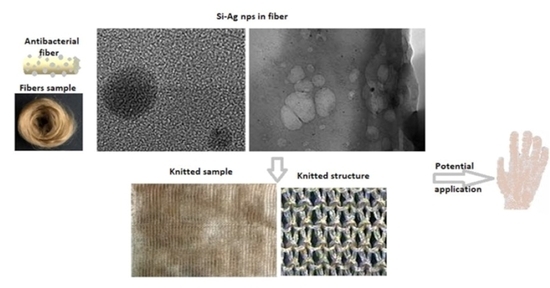Knitted Structures Made of Antibacterial Fibers Intended for Protective Gloves
Abstract
1. Introduction
2. Materials and Methods
2.1. Materials
2.2. Fabrication of Knitted Structures from Selected Fibers
- K-001—knitted fabric made of unmodified cellulose fibers.
- K-002—knitted fabric made of cellulose fibers modified with nanosilica with immobilized silver nanoparticles in the amount of about 500 ppm (F-500), fabricated on a machine with a needle knock-over depth lower than in variant I (K-001).
- K-003—knitted fabric made of cellulose fibers modified with nanosilica with immobilized silver nanoparticles in the amount of about 500 ppm (F-500), fabricated on a machine with a needle knock-over depth equal to variant I (K-001).
- machine diameter (in inches) φ = 4″
- needle gauge E14
- number of needles I = 169
- revolutions per minute n = 50–200 min−1
2.3. Methods for Determining the Structural and Physical Parameters of Knitted Fabrics Made of Lyocell Fibers
2.3.1. Course and Wale Density of Knitted Fabrics
2.3.2. Fabric Areal Density
2.3.3. Fabric Thickness
2.3.4. Tensile Strength and Relative Elongation of Knitted Fabrics
2.4. Methods for Testing Protective Knitted Fabrics Affecting User Comfort in Protective Glove Applications
2.4.1. Water Vapor Absorption
2.4.2. Water Vapor Permeability
2.4.3. Water Absorption and Desorption Taking into Account the End of Service Life
2.4.4. Abrasion Resistance Taking into Account the End of Service Life
2.4.5. Cut Resistance
2.4.6. Tear Resistance
2.4.7. pH of Aqueous Extracts
3. Results and Discussion
3.1. Characteristics of Knitted Fabrics Made of Lyocell Fibers
3.2. Structural and Physical Parameters of Knitted Fabrics Made of Lyocell Fibers
3.2.1. Determination of Course and Wale Densities of Knitted Fabrics
3.2.2. Determination of Fabric Thickness and Areal Density
3.2.3. Determination of Tensile Strength and Relative Elongation of Knitted Fabrics
3.3. Methods of Testing Protective Knitted Fabrics Affecting User Comfort for Applications in Protective Gloves
3.3.1. Absorption, Desorption, and Permeability Properties of Knitted Fabric Intended for Protective Gloves
3.3.2. Cut, Abrasion, and Tear Resistance of the Knitted Fabric Intended for Protective Gloves
3.3.3. pH of Aqueous Extracts from Knitted Fabric Intended for Protective Gloves
4. Conclusions
Author Contributions
Funding
Institutional Review Board Statement
Informed Consent Statement
Data Availability Statement
Acknowledgments
Conflicts of Interest
References
- Uddin, M.A.; Afroj, S.; Hasan, T.; Carr, C.; Novoselov, K.S.; Karim, N. Environmental Impacts of Personal Protective Clothing Used to Combat COVID-19. Adv. Sustain. Syst. 2022, 6, 2100176. [Google Scholar] [CrossRef] [PubMed]
- Verbeek, J.H.; Rajamaki, B.; Ijaz, S.; Sauni, R.; Toomey, E.; Blackwood, B.; Tikka, C.; Ruotsalainen, J.H.; Kilinc Balci, F.S. Personal protective equipment for preventing highly infectious diseases due to exposure to contaminated body fluids in healthcare staff. Cochrane Database Syst. Rev. 2020, 4, CD011621. [Google Scholar] [PubMed]
- Amit, N.; Neswara, P. Market Research Report, Antimicrobial Textiles Market Size, Share & COVID-19 Impact Analysis, By Active Agents (Synthetic Organic Compounds, Bio-Based Compounds, Metal & Metallic Salts and Others), By Fabric (Cotton, Polyester, and Others), By Application (Home, Commercial, Medical, Apparel, Industrial, and Others) and Regional Forecasts, 2021–2028. 2021, p. 100. Available online: https://www.fortunebusinessinsights.com/antimicrobial-textiles-market-102307 (accessed on 19 October 2023).
- Gao, Y.; Cranston, R. Recent Advances in Antimicrobial Treatments of Textiles. Text. Res. J. 2008, 78, 60–72. [Google Scholar]
- TEXINTEL. The New Sensil® Biocare Fibre from NILIT Improves Textile Impact on Ecosystems and Reduces Waste Accumulation in Both Oceans and Landfills. Available online: https://www.texintel.com/eco-news/the-new-sensil-biocare-fibre-from-nilit-improves-textile-impact-on-ecosystems-and-reduces-waste-accumulation-in-both-oceans-and-landfills (accessed on 26 June 2023).
- NYLSTAR. MERYL® SKINLIFE. Available online: https://www.nylstar.com/meryl-skinlife-3/ (accessed on 26 June 2023).
- INVISTA Completes Sale of APPAREL & Advanced Textiles Business. Available online: https://www.invista.com/news/invista-completes-sale-of-apparel-advanced-textiles-business (accessed on 19 October 2023).
- Khude, P.; Majumdar, A.; Butola, B.S. Leveraging the antibacterial properties of knitted fabrics by admixture polyester-silver nanocomposite fibres. Fibers Polym. 2018, 19, 1403–1410. [Google Scholar] [CrossRef]
- Ramazan, E.; Rajendran, S. Influence of Silver Loaded Antibacterial Agent on Knitted and Nonwoven Fabrics and Some Fabric Properties. J. Eng. Fibers Fabr. 2016, 11, 38–46. [Google Scholar]
- Tao, X.; Liu, S.; Liang, L.; Huang, X.U.S. Bio-Based Degradable Knitted Fabric with Antibacterial Effect. U.S. Patent No. 10,577,726 B2, 3 March 2020. [Google Scholar]
- Mickevičienė, A.; Treigienė, R. The Structure Characteristics and Air Permeability of PA and PES Plain and Plated Knits Influenced of Antimicrobial Treatment Conditions. Mater. Sci. 2014, 20, 306–310. [Google Scholar] [CrossRef][Green Version]
- Yu, Z.-C.; Zhang, J.-F.; Lou, C.-W.; He, H.-L.; Chen, A.-P.; Lin, J.-H. Determination of electromagnetic shielding and antibacterial properties of multifunctional warp-knitted fabrics. J. Text. Inst. 2014, 106, 1203–1211. [Google Scholar] [CrossRef]
- Asfand, N.; Daukantienė, V. A study of the physical properties and bending stiffness of antistatic and antibacterial knitted fabrics. Text. Res. J. 2021, 92, 957–1354. [Google Scholar] [CrossRef]
- Ivanauskas, R.; Bronusiene, A.; Ivanauskas, A.; Šarkinas, A.; Ancutiene, I. Antibacterial Activity of Copper Particles Embedded in Knitted Fabrics. Materials 2022, 15, 7147. [Google Scholar] [CrossRef] [PubMed]
- Edmiston, C.E.; Zhou, S.S.; Hoerner, P.; Krikorian, R.; Krepel, C.J.; Lewis, B.D.; Brown, K.R.; Rossi, P.J.; Graham, M.B.; Seabrook, G.R. Evaluation of an antimicrobial surgical glove to inactivate live human immunodeficiency virus following simulated glove puncture. Surg. J. 2013, 153, 225–233. [Google Scholar] [CrossRef] [PubMed]
- Reitzel, R.; Rosenblatt, J.; Jiang, Y.; Hachem, R.; Raad, I. Disposable gendine antimicrobial gloves for preventing transmission of pathogens in health care settings. Am. J. Infect. Control 2014, 42, 55–59. [Google Scholar] [CrossRef] [PubMed]
- How, S.W.; Low, D.Y.S.; Leo, B.F.; Manickam, S.; Goh, B.H.; Tang, S.Y. A critical review on the current state of antimicrobial glove technologies: Advances, challenges and future prospects. J. Hosp. Infect. 2023, 137, 24–34. [Google Scholar] [CrossRef] [PubMed]
- PN-EN 420+A1:2012; Rękawice Ochronne—Wymagania Ogólne i Metody Badań [Protective Gloves—General Requirements and Test Methods]. Polish Committee for Standardization: Warsaw, Poland, 2012.
- PN-EN 388+A1:2019-01; Rękawice Chroniące przed Zagrożeniami Mechanicznymi [Protective Gloves against Mechanical Risks]. Polish Committee for Standardization: Warsaw, Poland, 2019.
- EU Official Journal. L.2016.81.51 Regulation (EU) 2016/425 of the European Parliament and of the Council of 9 March 2016 on personal protective equipment and repealing Council Directive 89/686/EEC; European Union: Brussels, Belgium, 2016. [Google Scholar]
- Irzmańska, E.; Dyńska-Kukulska, K.; Jurczyk-Kowalska, M. Characteristics of microstructural phenomena occurring on the surface of protective gloves by the action of mechanical and chemical factors. Polimery 2014, 59, 136–146. [Google Scholar] [CrossRef]
- Irzmańska, E.; Stefko, A.; Dyńska-Kukulska, K. Factors influencing the end of the service life of protective gloves used in car repair shop: A preliminary report. Arch. Environ. Occup. Health 2015, 70, 81–90. [Google Scholar]
- Irzmańska, E.; Stefko, A. Simulation method for assessing the end of service life of gloves used by workers exposed to mineral oils and mechanical factors. Int. J. Ind. Ergon. 2015, 47, 61–71. [Google Scholar] [CrossRef]
- Smiechowicz, E.; Niekraszewicz, B.; Strzelinska, M.; Zielecka, M. Antibacterial fibers containing nanosilica with immobilized silver nanoparticles. Autex Res. J. 2020, 20, 441–448. [Google Scholar] [CrossRef]
- PN-EN 14971:2007; Tekstylia—Dzianiny—Wyznaczanie Liczby Oczek na Jednostkę Długości i Jednostkę Powierzchni (Textiles—Knitted Fabrics—Determination of Number of Stitches per Unit Length and Unit Area). Polish Committee for Standardization: Warsaw, Poland, 2007.
- PN-P-04613:1997; Tekstylia—Dzianiny i Przędziny—Wyznaczanie Masy Liniowej i Powierzchniowej (Textiles—Knitted and Stitch Bonded Fabrics—Determination of Mass per Unit Length and Mass per Unit Area). Polish Committee for Standardization: Warsaw, Poland, 1997.
- PN-EN ISO 5084:1999; Tekstylia—Wyznaczanie grubości wyrobów włókienniczych (Textiles—Determination of thickness of textiles and textile products). Polish Committee for Standardization: Warsaw, Poland, 1999.
- PN-EN ISO 13934-1:2013-07; Textiles—Tensile properties of fabrics—Part 1: Determination of maximum force and elongation at maximum force using the strip method. Polish Committee for Standardization: Warsaw, Poland, 2013.
- PN-EN 20344:2012; Środki ochrony indywidualnej—Metody badania obuwia [Personal protective equipment—Test methods for footwear]. Polish Committee for Standardization: Warsaw, Poland, 2012.
- PN-EN ISO 3071:2020-8; Tekstylia—Oznaczanie pH ekstraktów wodnych [Textiles—Determination of pH of aqueous extract]. Polish Committee for Standardization: Warsaw, Poland, 2020.
- Smiechowicz, E.; Kulpiński, P.; Niekraszewicz, B.; Bemska, J.; Morgiel, J. Effect of silver on cellulose fibre colour. Color Technol. 2014, 130, 424–431. [Google Scholar] [CrossRef]
- Smiechowicz, E.; Niekraszewicz, B.; Kulpinski, P.; Dzitko, K. Antibacterial composite cellulose fibers modified with silver nanoparticles and nanosilica. Cellulose 2018, 25, 3499–3517. [Google Scholar] [CrossRef]

| Knitted Fabric K-001 | |
|---|---|
| Back of the sample | Face of the sample |
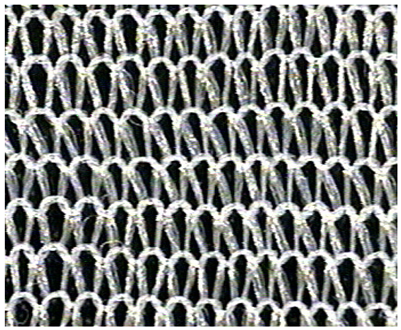 | 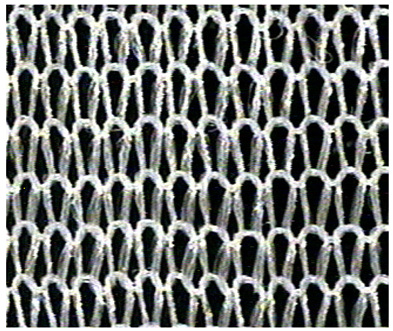 |
| Knitted Fabric K-002 | |
|---|---|
| Back of the sample | Face of the sample |
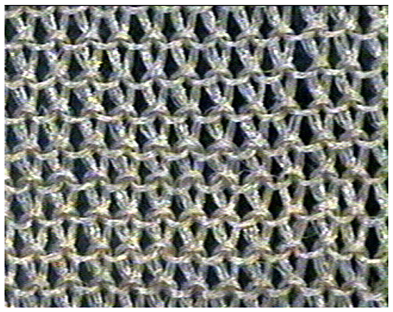 | 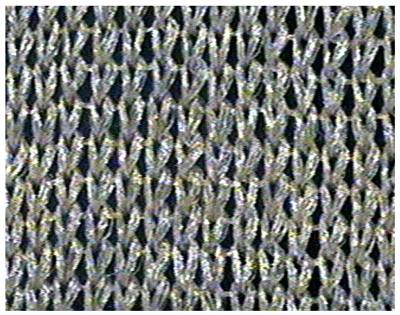 |
| Knitted Fabric K-003 | |
|---|---|
| Back of the sample | Face of the sample |
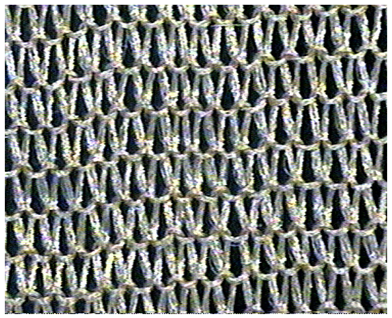 | 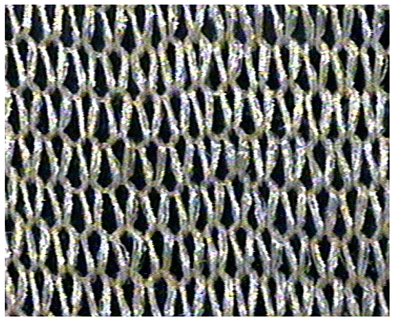 |
| Sample Symbol | Wale Density [Number of Loops/10 cm] | Standard Deviation [Number of Loops/10 cm] | Variation Coefficient [%] |
|---|---|---|---|
| K-001 | 173 | 1.22 | 0.71 |
| K-002 | 178 | 0.84 | 0.47 |
| K-003 | 172 | 1.14 | 0.66 |
| Sample Symbol | Course Density [Number of Loops/10 cm] | Standard Deviation [Number of Loops/10 cm] | Variation Coefficient [%] |
|---|---|---|---|
| K-001 | 88 | 1.10 | 1.25 |
| K-002 | 114 | 1.00 | 0.88 |
| K-003 | 87 | 1.41 | 1.63 |
| Sample Symbol | Areal Density [g/m2] | Standard Deviation [g/m2] | Variation Coefficient [%] |
|---|---|---|---|
| K-001 | 49.32 | 3.00 | 6.08 |
| K-002 | 56.38 | 2.46 | 4.36 |
| K-003 | 50.82 | 1.90 | 3.73 |
| Sample Symbol | Thickness [mm] | Standard Deviation [mm] | Variation Coefficient [%] |
|---|---|---|---|
| K-001 | 0.37 | 0.01 | 2.25 |
| K-002 | 0.38 | 0.01 | 2.19 |
| K-003 | 0.35 | 0.01 | 1.58 |
| Sample Symbol | Maximum Force [N] | Standard Deviation [N] | Variation Coefficient [%] | |||
|---|---|---|---|---|---|---|
| Along Wales | Along Courses | Along Wales | Along Courses | Along Wales | Along Courses | |
| K-001 | 216.95 | 22.95 | 16.05 | 1.84 | 0.07 | 0.08 |
| K-002 | 177.70 | 44.78 | 11.74 | 1.31 | 0.07 | 0.03 |
| K-003 | 209.55 | 29.75 | 12.37 | 3.89 | 0.06 | 0.13 |
| Sample Symbol | Relative Elongation [%] | Standard Deviation [%] | Variation Coefficient [%] | |||
|---|---|---|---|---|---|---|
| Along Wales | Along Courses | Along Wales | Along Courses | Along Wales | Along Courses | |
| K-001 | 20.14 | 366.00 | 2.91 | 8.49 | 0.14 | 0.02 |
| K-002 | 39.10 | 382.00 | 2.97 | 2.83 | 0.08 | 0.01 |
| K-003 | 22.80 | 390.00 | 1.99 | 8.49 | 0.09 | 0.02 |
| Fabric K-003 | |
| Water vapor absorption by materials PN-EN 420+A1:2012, point 6.4 | |
| Water vapor absorption 0.3 mg/cm2 | Fails to meet the normative requirements Water vapor absorption during 8 h should be ≥8 mg/cm2 |
| Water vapor permeability through materials PN-EN 420+A1:2012, point 6.3 | |
| Water vapor permeability 100.4 mg/cm2·h | Meets the normative requirements Mean water vapor permeability should be ≥5 mg/cm2·h |
| Fabric K-003 | |
| Water absorption and desorption According to the procedure for determining the end of service life | |
| Absorption 24 mg/cm2 | Fails to meet the normative requirements Water absorption should be ≥70 mg/cm2 |
| Desorption 100% | Meets the normative requirements Water desorption should be ≥80% of absorbed water |
| Fabric K-003 | ||
| Cut resistance tests using the Couptest apparatus PN-EN 388+A1:2019-01, point 6.2 | ||
| Indicator I 1.2 | Uncertainty ±0.1 | Meets the normative requirements Fabric K-003 reached performance level one (at an indicator of I 1.2) |
| Tear resistance PN-EN 388+A1:2019-01 p. 6.4 | ||
| Tear resistance [N] 2 N | Uncertainty ±0.2 | Fails to meet the normative requirements (performance level one at 10 N) |
| Fabric K-003 | ||
| Resistance of footwear lining to abrasion In accordance with the procedure for determining the end of service life | ||
| Abrasion resistance [no. of cycles] Wet test (12,800–25,600) | Qualitative test | Meets the normative requirements Abrasion wear after 1000 cycles |
| Abrasion resistance [no. of cycles] Dry test (25,600–51,200) | Qualitative test | Meets the normative requirements Abrasion wear after 6500 cycles |
| Fabric K-003 | |
| The pH of aqueous extracts from knitted fabric PN-EN ISO 3071:2020-8 | |
| pH 5.8 | Normative requirements pH between 3.5 and <9.5 |
Disclaimer/Publisher’s Note: The statements, opinions and data contained in all publications are solely those of the individual author(s) and contributor(s) and not of MDPI and/or the editor(s). MDPI and/or the editor(s) disclaim responsibility for any injury to people or property resulting from any ideas, methods, instructions or products referred to in the content. |
© 2023 by the authors. Licensee MDPI, Basel, Switzerland. This article is an open access article distributed under the terms and conditions of the Creative Commons Attribution (CC BY) license (https://creativecommons.org/licenses/by/4.0/).
Share and Cite
Smiechowicz, E.; Niekraszewicz, B.; Klonowska, M.; Strzelinska, M.; Irzmanska, E.; Litwicka, N. Knitted Structures Made of Antibacterial Fibers Intended for Protective Gloves. Materials 2023, 16, 7276. https://doi.org/10.3390/ma16237276
Smiechowicz E, Niekraszewicz B, Klonowska M, Strzelinska M, Irzmanska E, Litwicka N. Knitted Structures Made of Antibacterial Fibers Intended for Protective Gloves. Materials. 2023; 16(23):7276. https://doi.org/10.3390/ma16237276
Chicago/Turabian StyleSmiechowicz, Emilia, Barbara Niekraszewicz, Magdalena Klonowska, Marta Strzelinska, Emilia Irzmanska, and Natalia Litwicka. 2023. "Knitted Structures Made of Antibacterial Fibers Intended for Protective Gloves" Materials 16, no. 23: 7276. https://doi.org/10.3390/ma16237276
APA StyleSmiechowicz, E., Niekraszewicz, B., Klonowska, M., Strzelinska, M., Irzmanska, E., & Litwicka, N. (2023). Knitted Structures Made of Antibacterial Fibers Intended for Protective Gloves. Materials, 16(23), 7276. https://doi.org/10.3390/ma16237276





